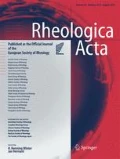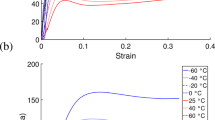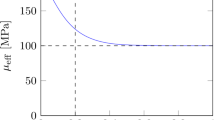Abstract
Polyvinyl chloride (PVC) is widely used in industry, but it is difficult to find any extensive discussion of theological relations that describe it. The present paper discusses the behaviour of rigid PVC in extensional deformations at various temperatures. In the tests, a step elongation was applied at an initial time, then after a delay the specimen was cut, permitting recoil. Both linear and nonlinear strain regimes were studied; the linear relaxation properties (relaxation function, storage modulus) were cross-checked with eccentric-disk measurements. In the non-linear strain regime a single-integral constitutive equation of the KBKZ Wagner type was used. Separability of time and strain effects was demonstrated in our tests and so a “damping function” could be found which was only a function of strain. Video recordings of recoil were made, and detailed predictions of the strain-time behaviour were checked against experiments.
Various constitutive equation proposals were used in the comparison, and the separated kernel integral irreversible model performed reasonably well; some other models of a differential type, and a Doi-Edwards model were not as accurate.
Similar content being viewed by others
References
Bernstein B, Kearsley EA, Zapas LJ (1963) A study of stress relaxation with finite strain. Trans Soc Rheol 7:391–410
Kaye A (1962) Non-Newtonian flow in incompressible liquids. College of Aeronautics, Note No 134
Lodge AS (1964) Elastic liquids. Academic Press, New York
Wagner MH (1976) Analysis of time-dependent nonlinear stress-growth data for shear and elongational flow of a low-density branched polyethylene melt. Rheol Acta 15:136–142
Wagner MH, Demarmels A (1990) A constitutive analysis of extensional flows of polyisobutylene. J Rheol 34:943–958
Wagner MH, Stephenson SE (1979) The spike-strain test for polymeric liquids and its relevance for irreversible destruction of network connectivity by deformation. Rheol Acta 18:463–468
Doi M, Edwards SF (1986) Theory of polymer dynamics. Oxford University Press, Oxford
Currie PK (1982) Constitutive equations for polymer melts predicted by the Doi-Edwards and Curtiss-Bird kinetic theory models. J Non-Newtonian Fluid Mech 11:53–68
Wagner MH (1990) The nonlinear strain measure of polyisobutylene melt in general biaxial flow and its comparison to the Doi-Edwards model. Rheol Acta 29:594–603
Larson RG (1988) Constitutive equations for polymer melts and solutions. Butterworth Publishers, Massachusetts
Larson RG (1984) A constitutive equation for polymer melts based on partially extending strand convection. J Rheol 28:545–571
Larson RG, Valesano VA (1986) Are polymer melts visco-anelastic? J Rheol 30:1093–1108
Phan-Thien N, Tanner RI (1977) A new constitutive equation derived from network theory. J Non-Newtonian Fluid Mech 2:353–365
Khan SA, Larson RG (1987) Comparison of simple constitutive equations for polymer melts in shear and biaxial and uniaxial extensions. J Rheol 31:207–234
Wagner MH (1978) A constitutive analysis of uniaxial elongational flow data of a low-density polyethylene melt. J Non-Newtonian Fluid Mech 4:39–55
Bird RB, Armstrong RC, Hassager O (1987) Dynamics of polymeric liquids, vol 1: Fluid mechanics, 2nd ed. Wiley, New York
Khan MMK, Tanner RI (1990) Rheology of an LDPE melt in reversing multi-step shear and elongational flows. Rheol Acta 29:281–297
Laun HM, Munstedt H (1978) Elongational behaviour of a low density polyethylene melt. Rheol Acta 17:415–425
ASTM Standard D638 (1985) Test method for tensile properties of plastics
ASTM Standard E8 (1985) Methods of tension testing of metallic materials
Tanner RI (1988) Engineering rheology, revised ed. Clarendon Press, Oxford
Ferry JD (1970) Viscoelastic properties of polymers, 2nd ed. Wiley, New York
Pipkin AC (1972) Lectures on viscoelasticity theory. Springer, New York
Crugnola A, Pegoraro M, Danusso F (1968) High-temperature mechanical behaviour of unplasticized poly(vinyl chloride). J Polym Sci A2, 6:1705–1722
Caswell B, Paboojian SJ (1991) Similarity rule for the relaxation modulus of polydisperse polymers. J Rheol, to appear
Bonnebat C, DeVries AJ (1978) Dynamic-mechanical behaviour of poly(vinyl chloride), PVC, and chlorinated PVC compounds in the range of processing temperatures. Polym Eng Sci 18:824–832
Collins EA (1977) The rheology of PVC — An overview. Pure Appl Chem 49:581–595
Meissner J (1975) Basic parameters, melt rheology, processing and end-use properties of three similar low density polyethylene samples. Pure Appl Chem 42:551–623
Author information
Authors and Affiliations
Additional information
Dedicated to Professor Arthur S. Lodge on the occasion of his 70th birthday and his retirement from the University of Wisconsin.
Rights and permissions
About this article
Cite this article
Zdilar, A.M., Tanner, R.I. The recoil of rigid PVC. Rheol Acta 31, 44–54 (1992). https://doi.org/10.1007/BF00396466
Received:
Issue Date:
DOI: https://doi.org/10.1007/BF00396466




